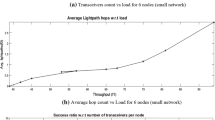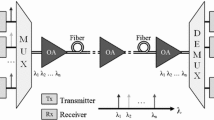Abstract
Traffic grooming in optical networks is the process of multiplexing and demultiplexing low-speed traffic streams onto high-speed wavelengths. The research in the domain of traffic grooming mainly focuses on minimizing number of SONET add/drop multiplexers (SADMs) in SONET/WDM rings and it has been shown that they can potentially be reduced by careful assignment of low-speed traffic streams onto high-speed wavelengths. However, the cost of the network not only depends on the number of SADMs, but also the number of wavelengths and the grooming ratio. It is often the case that all of them cannot be minimized simultaneously. In this article, the problem of minimization of cost of a SONET/WDM unidirectional ring has been modeled as a multiobjective optimization problem which simultaneously minimizes the number of SADMs, the number of wavelengths, and the grooming ratio. A popular multiobjective genetic algorithm (NSGA-II) has been used as the underlying optimization tool. The resultant set of near-Pareto-optimal solutions contains a number of nondominated solutions, which the user can judge relatively and pick up the most promising one according to the problem requirements. Performance of the proposed algorithm has been demonstrated on different network topologies.
Similar content being viewed by others
References
Mohan G., Siva Rama Murthy C.: WDM Optical Networks: Concepts, Design and Algorithms. Prentice Hall, New Jersey (2001)
Mukhopadhyay, A., Singh, J.K., Biswas, U., Naskar, M.K.: Distributed approaches for dynamic traffic grooming in WDM optical networks. In: Proc. Int. Conf. CODEC-04, January, Kolkata, India, p. P-55 (2004)
Mukhopadhyay, A., Singh, J.K., Biswas, U., Naskar, M.K.: Improved distributed approaches for dynamic traffic grooming in WDM optical networks. In: Proc. Int. Conf. DPN-04, June, Kharagpur, India, pp. 92–96 (2004)
Mukhopadhyay, A., Biswas, U., Naskar, M.K., Maulik, U., Bandyopadhyay, S.: Minimization of SADMs in unidirectional SONET/WDM rings using genetic algorithms, chap. 14. In: Handbook of Bioinspired Algorithms and Applications. Chapman and Hall, Boca Raton (2006)
Mukhopadhyay, A., Biswas, U., Naskar, M.K.: A genetic algorithm for traffic grooming in unidirectional SONET/WDM rings. In: Proc. Int. Conf. IEEE INDICON-04, December, Kharagpur, India, pp. 252–255 (2004)
Dutta R., Rouskas N.: On optimal traffic grooming in WDM rings. IEEE J. Sel. Areas Commun. 20(1), 110–121 (2002)
Gerstel O., Ramaswami R., Sasaki G.: Cost-effective traffic groomings in WDM rings. IEEE/ACM Trans. Netw. 8(5), 618–630 (2000)
Hu J.Q.: Optimal traffic grooming for wavelength- division-multiplexing rings with all-to-all uniform traffic. OSA J. Opt. Netw. 1(1), 32–42 (2002)
Hu, J., Leida, B.: Traffic grooming, routing and wavelength assignment in optical WDM mesh networks. In: Proc. IEEE INFOCOM’04, March, vol. 1, pp. 495–501 (2004)
Chiu A.L., Modiano E.H.: Traffic grooming algorithms for reducing electronic multiplexing costs in WDM ring networks. IEEE/OSA J. Lightw. Technol. 18, 2–12 (2000)
Modiano E.H., Lin P.J.: Traffic grooming in WDM networks. IEEE Commun. Mag. 39, 124–129 (2001)
Wang J., Vemuri V.R., Cho W., Mukherjee B.: Improved approaches for cost-effective traffic grooming in WDM ring networks: ILP formulations and single-hop and multihop connections. IEEE/OSA J. Lightw. Technol. 19(11), 1645– 1653 (2001)
Goldberg D.E.: Genetic Algorithms in Search, Optimization and Machine Learning. Addison-Wesley, New York (1989)
Davis, L. (eds): Handbook of Genetic Algorithms. Van Nostrand Reinhold, New York (1991)
Michalewicz Z.: Genetic Algorithms + Data Structures = Evolution Programs. Springer-Verlag, New York (1992)
Maulik U., Bandyopadhyay S.: Genetic algorithm based clustering technique. Pattern Recognit. 33, 1455–1465 (2000)
Maulik U., Bandyopadhyay S.: Fuzzy partitioning using a real-coded variable-length genetic algorithm for pixel classification. IEEE Trans. Geosci. Remote Sens. 41(5), 1075–1081 (2003)
Deb K.: Multi-Objective Optimization Using Evolutionary Algorithms. Wiley, England (2001)
Deb K., Pratap A., Agrawal S., Meyarivan T.: A fast and elitist multiobjective genetic algorithm: NSGA-II. IEEE Trans. Evol. Comput. 6, 182–197 (2002)
Coello Coello C.A.: A comprehensive survey of evolutionary-based multiobjective optimization techniques. Knowl. Inf. Syst. 1(3), 129–156 (1999)
Bandyopadhyay S., Mukhopadhyay A., Maulik U.: An improved algorithm for clustering gene expression data. Bioinformatics 23(21), 2859–2865 (2007)
Bandyopadhyay S., Maulik U., Mukhopadhyay A.: Multiobjective genetic clustering for pixel classification in remote sensing imagery. IEEE Trans. Geosci. Remote Sens. 45(5), 1506–1511 (2007)
Bandyopadhyay S., Saha S., Maulik U., Deb K.: A simulated annealing-based multiobjective optimization algorithm: AMOSA. IEEE Trans. Evol. Comput. 12(3), 269–283 (2008)
Deb, K., Agrawal, S., Pratap, A., Meyarivan, T.: A fast elitist non-dominated sorting genetic algorithm for multi-objective optimization: NSGA-II. In: Proceedings of the Parallel Problem Solving from Nature VI Conference, Paris, France. Lecture Notes in Computer Science, vol. 1917, pp. 849–858. Springer, Berlin (2000)
Zitzler, E., Thiele, L.: An evolutionary algorithm for multiobjective optimization: the strength Pareto approach. Technical Report 43. Federal Institute of Technology (ETH), Gloriastrasse 35, CH-8092 Zurich, Switzerland, (1998)
Zitzler, E., Laumanns, M., Thiele, L.: SPEA2: improving the strength Pareto evolutionary algorithm. Technical Report 103. Federal Institute of Technology (ETH), Gloriastrasse 35, CH-8092 Zurich, Switzerland (2001)
Cormen T.H., Leiserson C.E., Rivest R.L., Stein C.: Introduction to Algorithms. MIT Press, Cambridge (2001)
Pryke, A., Mostaghim, S., Nazemi, A.: Heatmap visualisation of population based multi objective algorithms. In: Proc. 4th Int. Conf. EMO’07, March, Matshushima, Japan, pp. 361–375 (2007)
Author information
Authors and Affiliations
Corresponding author
Rights and permissions
About this article
Cite this article
Biswas, U., Maulik, U., Mukhopadhyay, A. et al. Multiobjective evolutionary approach to cost-effective traffic grooming in unidirectional SONET/WDM rings. Photon Netw Commun 18, 105–115 (2009). https://doi.org/10.1007/s11107-008-0174-6
Received:
Accepted:
Published:
Issue Date:
DOI: https://doi.org/10.1007/s11107-008-0174-6




